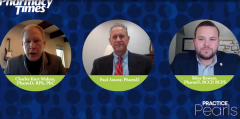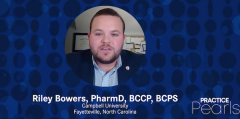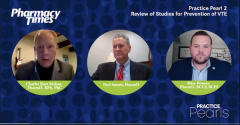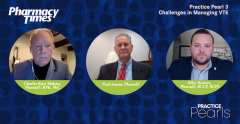
Practice Pearl 2: Review Guidelines for the Treatment of VTE
Paul Ament, PharmD, reviews the guidelines for the treatment of VTE.
Episodes in this series

Charles Kurt Mahan, PharmD, RPh, PhC: Let’s shift into guidelines for the treatment of venous thromboembolism [VTE], and you could touch on some of the updates on those.
Paul Ament, PharmD: It’s important to appreciate that DVT [deep vein thrombosis] is primarily an outpatient treatment unless you have an iliofemoral clot, where interventional radiology feels that the clot burden is so high that they need to do a procedure. What we have done within our health system [Excela Health] is this: We stock the starter doses of both apixaban and rivaroxaban in the emergency department, so the patients leave the hospital with it. That eliminates the issue of whether the patient will go to their pharmacy to pick it up. Does the pharmacy have starter-pack dosage product available?
We’ve taken that factor out of the hands, and we then have an outpatient pharmacy that does the billing to be able to utilize the free trial. In 2016, there was an update to the ACCP [American College of Chest Physician] guidelines, and what they recommended was that the direct oral anticoagulants [DOACs] were now drugs of choice over low molecular weight heparin being bridged to warfarin. In that position paper, they still favored low molecular weight heparin in patients who had active cancer. It’s interesting to note they did not recommend bridging to warfarin in patients with active cancer but to continue low molecular weight heparin for at least 3 months.
When we’re looking at the management of pulmonary embolus [PE], it’s still the standard of care to bring those patients in maybe even just as an observation status. We have pretty good data where you can risk stratify based on the Hestia criteria or the PESI [Pulmonary Embolism Severity Index] scoring. We now have several studies, such as the MERCURY PE and HoT-PE [Home Treatment of Pulmonary Embolism] studies, showing that low-risk patients can be safely discharged right out of the emergency department without requiring them to be admitted. As we discussed in terms of VTE and cancer patients, in 2019, the ASCO [American Society of Clinical Oncology] Guidelines as well as the National Comprehensive Cancer Network Guidelines mentioned rivaroxaban and edoxaban to be drugs of choice in patients with active cancer.
Recently, the CARAVAGGIO study with apixaban showed efficacy, so the thinking is to use the DOACs in patients with active cancer. You may want to avoid it, though, in patients who would have a GI [gastrointestinal] malignancy because of the higher concern for GI bleeding. Lastly, I’ll make the point that when I’m called to see a patient to evaluate anticoagulation options, I never say to the patient, “I want to use rivaroxaban” or “I want to use apixaban in you because it’s more effective” because they clinically have not been shown to be more effective. I suggest to the patient that they’re recommended because of safety and simplicity. They’re much easier to use, and the clinical data definitely show the lower rate of major bleeding with the use of direct oral anticoagulants compared with Lovenox [enoxaparin] and warfarin bridging.
Charles Kurt Mahan, PharmD, RPh, PhC: That’s a great point. Intracranial hemorrhage [ICH], to your point, is pretty much a class effect where we’re seeing 50% to 60% less ICH with the use of DOACs, so that’s a great approach.
Newsletter
Stay informed on drug updates, treatment guidelines, and pharmacy practice trends—subscribe to Pharmacy Times for weekly clinical insights.






















































































































































































































